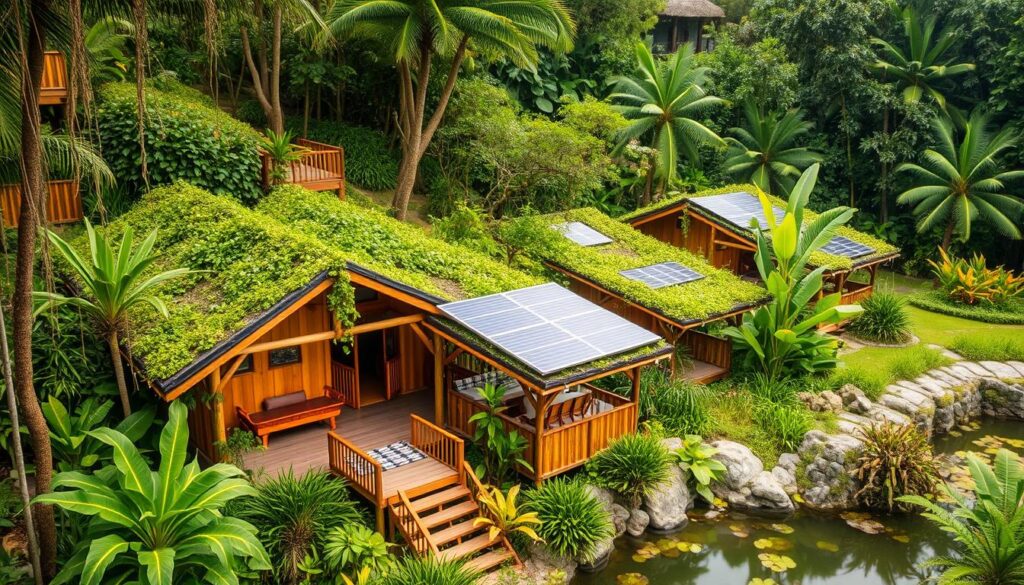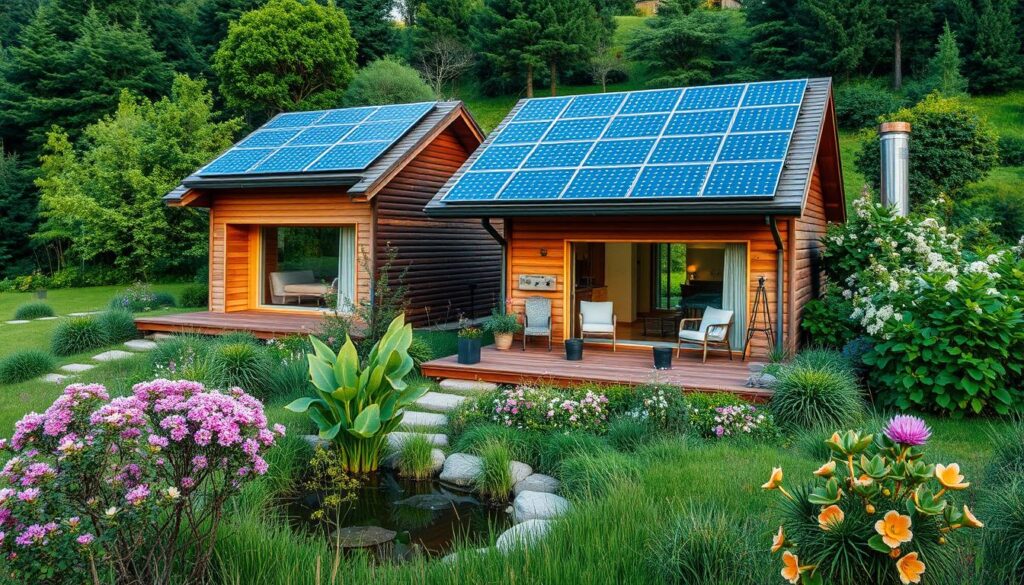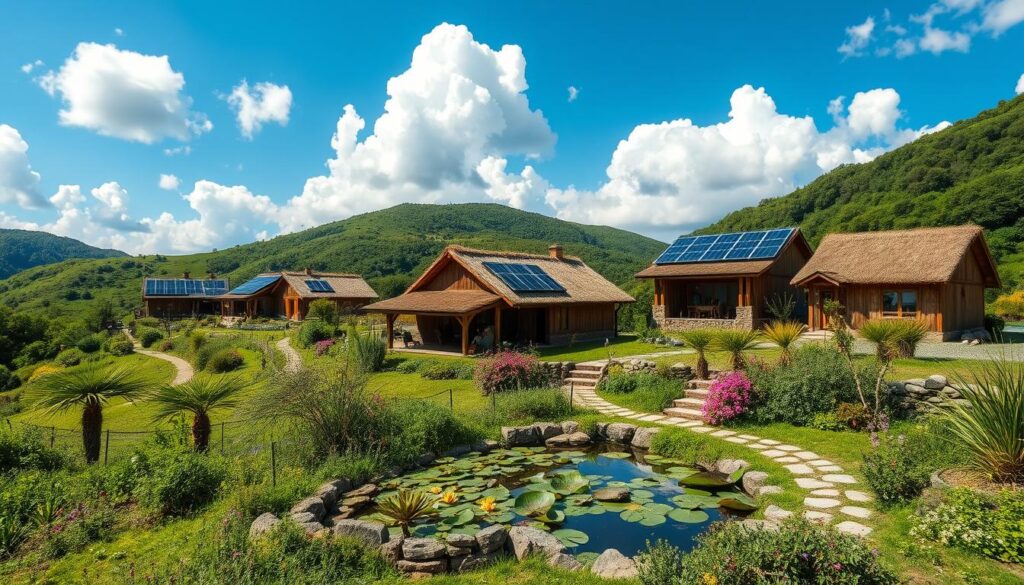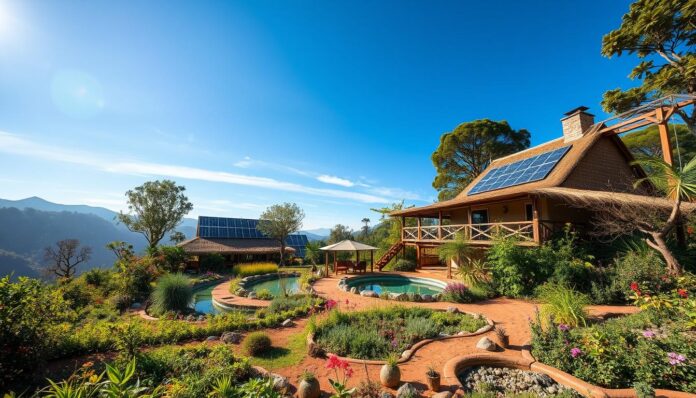Imagine creating a place where guests can live sustainably and enjoy nature. Permaculture eco-resorts do just that. They blend organic farming, eco-friendly stays, and nature walks. This mix attracts travelers who care about the planet.
These resorts work with nature, using methods like companion planting. For example, Soneva’s compost system makes 20,000 kg of compost monthly. This helps grow veggies and connects guests with nature.
Visiting a sustainable living retreat is a chance to see permaculture up close. By applying permaculture to an eco-resort, owners create a special place. It draws travelers who want to live green.
Key Takeaways
- Permaculture eco-resorts combine organic farming, eco-friendly accommodations, and nature immersion experiences to promote sustainability.
- Approximately 73% of travelers are more likely to select accommodation that implements sustainability practices.
- Permaculture practices, such as companion planting and regenerative agriculture, can promote biodiversity and reduce waste.
- Soneva’s compost system produces approximately 20,000 kg of new compost every month, supporting a soil pH range between 6 and 8.
- Hotels using solar panels can save over $1,500 in energy costs and earn approximately $16,000 in renewable energy credits.
- Implementing rainwater harvesting and gray water recycling can reduce water consumption by 30% and 40%, respectively.
Introduction to Permaculture Eco-Resorts
Permaculture eco-resorts offer a special nature immersion experience. Guests can connect with nature and learn about sustainable living. These places provide eco-friendly accommodations and aim to be carbon-neutral.
For those curious about permaculture, there are many resources. You can find a guide on starting a permaculture lifestyle.
What is Permaculture?
Permaculture is a design system for sustainable ecosystems. It works with nature to create diverse and thriving environments.
The Concept of Eco-Resorts
Eco-resorts aim to reduce their environmental impact. They offer a unique experience and promote sustainable living. Guests can enjoy activities like hiking and birdwatching.
Synergy Between Permaculture and Eco-Tourism
Permaculture and eco-tourism work well together. Resorts like Playa Viva use permaculture to create sustainable ecosystems. They offer organic food, eco-friendly accommodations, and a nature immersion experience.
These resorts show how permaculture can create sustainable ecosystems. They provide a unique experience for guests while promoting eco-friendly accommodations and nature immersion.
Key Principles of Permaculture
Permaculture is a way to design sustainable environments. It’s about living in harmony with nature and keeping ecosystems balanced. A sustainable living retreat or organic farming vacation lets you see permaculture in action.
Permaculture starts with observing and interacting with nature. This means noticing natural patterns and using that knowledge to design. It helps create a green tourism destination that’s good for the environment and helps it grow.
Observe and Interact
This principle is key for a sustainable ecosystem. By watching and working with nature, we learn about its complex relationships. This helps us create a strong and resilient environment.
Catch and Store Energy
This principle is about using and saving energy in all forms. For example, solar power and rainwater harvesting reduce our need for non-renewable energy. It makes for a more sustainable living retreat experience.
Value Diversity
This principle highlights the value of biodiversity. It promotes diversity in all forms to create a thriving ecosystem. This makes for a more organic farming vacation that’s both sustainable and regenerative.
Benefits of Permaculture Eco-Resorts
Permaculture eco-resorts offer a unique environmentally conscious getaway for travelers. They let you experience sustainable living in a stunning natural setting. These resorts use permaculture principles to reduce their ecological impact and support local economies.
Places like Nadi Bali and Playa Viva are great examples. They have community programs and reforestation efforts. These actions help the environment and support the local economy, showing the value of a permaculture eco resort.
The advantages of permaculture eco-resorts are clear in several areas:
- Ecological impact: They use sustainable design and eco-friendly features to lessen their environmental footprint and support biodiversity.
- Economic viability: These resorts help local communities by supporting sustainable tourism and promoting local development.
- Community engagement: They foster community engagement through cultural exchange and support for local development, making them ideal for a sustainable living retreat.
Site Selection and Analysis
Choosing the right site is key when building permaculture eco-resorts. It’s about finding land that’s perfect for eco-friendly accommodations and a deep nature immersion experience. The land’s climate, topography, and plants are important in making sure it’s right for carbon-neutral lodging.
Looking at the land’s geography is also crucial. This includes where the resort is located and how it affects the environment. For example, Finca Del Sol is on a volcanic island, and Playa Viva is by the sea. These locations show how important the site is for a unique nature immersion experience.
Geographic Considerations
Geography matters a lot when picking a site. The resort’s location can greatly affect its eco-friendly accommodations and how green it is. By picking a site that’s good for carbon-neutral lodging, resorts can reduce their harm to the environment.

Soil and Water Assessment
Checking the soil and water is vital for a sustainable site. This helps find the best spots for eco-friendly accommodations and a real nature immersion experience. It’s all about creating the perfect environment.
Designing Sustainable Facilities
Creating a sustainable living retreat, organic farming vacation, or green tourism destination starts with the facilities’ design. It’s important to use eco-friendly materials, focus on energy efficiency, and manage waste well. This helps reduce the place’s environmental impact.
For a sustainable living retreat, choose materials that are locally sourced, renewable, and recyclable. Bamboo is a great choice because it’s renewable. To save energy, use solar power, wind energy, and design that captures natural light. Also, composting and recycling can cut down waste significantly.
- Eco-friendly construction materials, such as bamboo and recycled materials
- Energy efficiency strategies, such as solar power and wind energy
- Waste management solutions, such as composting and recycling
By adding these features, a green tourism spot can lessen its environmental impact. It offers a unique, sustainable experience for guests. Whether it’s an organic farming vacation or a sustainable living retreat, the facilities’ design is key to success.
Creating Permaculture Gardens
Permaculture eco-resorts and sustainable living retreats often have permaculture gardens. These gardens aim to boost biodiversity and cut down on pesticides and fertilizers. Guests can enjoy fresh produce and connect deeply with nature during their stay.
Places like Finca Del Sol and Playa Viva show off permaculture’s power. Their gardens are examples of how to create sustainable ecosystems. These gardens offer guests a unique experience and promote sustainable food production.
Companion Planting Techniques
Companion planting is key in permaculture gardens. It involves planting different species together to help each other grow. For instance, marigolds can keep nematodes away from tomatoes, and basil can make tomatoes taste better.
Permaculture Zones Explained
Permaculture zones help design gardens for sustainability. Plants that need the most care are placed closest to homes. This setup reduces waste and the need for external inputs, making the garden more self-sufficient.
Integrating Edible Landscapes
Edible landscapes in permaculture gardens offer a unique experience. They include fruits, vegetables, and herbs for healthy meals. This way, guests can enjoy organic farming and connect with nature.
- Increased biodiversity
- Reduced need for pesticides and fertilizers
- Improved soil health
- Increased crop yields
- Unique and immersive experience for guests
Permaculture gardens in eco-resorts and retreats offer a chance to experience organic farming. Guests can connect with nature in a meaningful way.
| Permaculture Garden Benefits | Description |
|---|---|
| Increased Biodiversity | Permaculture gardens promote biodiversity by planting a variety of species together. |
| Reduced Need for Pesticides and Fertilizers | Permaculture gardens use companion planting and other techniques to reduce the need for pesticides and fertilizers. |
| Improved Soil Health | Permaculture gardens use techniques such as composting and mulching to improve soil health. |
Water Management in Permaculture
Effective water management is key for eco-friendly accommodations. Permaculture eco-resorts like Playa Viva use rainwater harvesting systems. This cuts down on carbon footprint and offers a carbon-neutral stay for guests.
Some important water management strategies in permaculture include:
- Rainwater harvesting systems to capture and store rainwater
- Permaculture swales and ponds to create a regenerative and sustainable ecosystem
- Sustainable irrigation practices, such as drip irrigation, to minimize water waste and promote water efficiency
These strategies help permaculture eco-resorts use less water. For instance, Nadi Bali’s swales make a sustainable ecosystem. They offer guests a unique nature experience.
Effective water management is vital for eco-friendly accommodations. It supports sustainable tourism and a nature immersion experience.
| Water Management Strategy | Benefits |
|---|---|
| Rainwater Harvesting | Reduces water usage, creates a carbon-neutral lodging experience |
| Permaculture Swales and Ponds | Creates a regenerative and sustainable ecosystem, provides a unique nature immersion experience |
| Sustainable Irrigation Practices | Minimizes water waste, promotes water efficiency |
Energy Solutions for Eco-Resorts
Eco-resorts are turning to renewable energy to cut down on carbon emissions. A sustainable living retreat can greatly benefit from solar and wind power. For example, Finca Del Sol uses solar energy, and Playa Viva harnesses wind power. These green energy solutions help the environment and attract eco-friendly travelers.
Organic farming practices are also key to energy efficiency. Resorts that focus on local, sustainable farming use less external resources. This, combined with renewable energy, cuts down greenhouse gas emissions. It makes these places more attractive to travelers who care about the planet.

Eco-resorts can also use passive solar design to save energy. This involves smart building layouts and materials to use natural light and heat. Adding energy storage like batteries ensures a steady power supply, even in remote spots. By adopting these solutions, eco-resorts offer a unique, sustainable experience. They become top choices for green tourism destinations.
| Energy Solution | Benefits |
|---|---|
| Reneable Energy Sources | Reduces carbon footprint, attracts environmentally conscious travelers |
| Passive Solar Design | Maximizes natural light and heat, reduces energy consumption |
| Energy Storage Options | Ensures stable and reliable energy supply, supports remote locations |
Implementing Social Structures
For an eco-friendly getaway, like a permaculture eco resort, social structures are key. Community-based governance spreads decision-making among members. These resorts also offer educational programs and workshops on sustainable living and permaculture.
A sustainable living retreat can offer volunteer chances. This lets guests help out and support the local area. Nadi Bali and Playa Viva show how important social permaculture is for a thriving community.
Some key aspects of social permaculture include:
- Community-based governance
- Educational programs and workshops
- Volunteer opportunities
These elements help create a sustainable community. A permaculture eco resort is perfect for those who want to live sustainably.
By focusing on social structures and sustainable living, a permaculture eco resort can lead in eco-friendly tourism. It offers a unique experience for guests while helping the local community and environment.
| Aspect | Description |
|---|---|
| Community-based governance | Distributed decision-making power among community members |
| Educational programs and workshops | Promoting sustainable living and permaculture principles |
| Volunteer opportunities | Allowing guests to participate in community activities and support the local environment |
Marketing Your Eco-Resort
To market your eco-resort well, show it as a special and green place. Offer eco-friendly accommodations and a nature immersion experience. Talk about your carbon-neutral lodging and green commitment.
Some key strategies for marketing your eco-resort include:
- Identifying your target audience and understanding their needs and preferences
- Developing an effective online presence, including a website and social media channels
- Utilizing search engine optimization (SEO) techniques to improve your resort’s visibility in online search results
For example, Finca Del Sol’s marketing strategy focuses on showcasing their 100% sustainable eco-lodge and organic permaculture farm. Playa Viva’s online presence highlights their eco-friendly accommodations and nature immersion experiences. By following these strategies, you can effectively market your eco-resort and attract environmentally conscious guests.

Additionally, consider the following benefits of marketing your eco-resort:
| Benefit | Description |
|---|---|
| Increased visibility | Reach a wider audience and increase your resort’s online presence |
| Targeted marketing | Attract environmentally conscious guests who are interested in eco-friendly accommodations and nature immersion experiences |
| Competitive advantage | Differentiate your resort from others in the industry and establish a reputation for sustainability |
Challenges of Operating an Eco-Resort
Running a sustainable living retreat, like an organic farming vacation or a green tourism spot, comes with big challenges. Issues like environmental rules, ups and downs in business, and keeping finances stable are major hurdles. For example, Nadi Bali’s story shows how hard it is to deal with environmental rules.
Some big challenges for eco-resorts include:
- Environmental regulations: Following these rules can be hard and take a lot of time.
- Seasonal business fluctuations: Changes in the seasons can affect how busy the resort is and its income.
- Financial sustainability: It’s tough to keep the resort financially stable, but finding new ways to make money and save costs can help.
Playa Viva shows how important it is to save money and find different ways to make money. By knowing these challenges, eco-resorts can get ready for the tough parts of running a sustainable retreat, vacation, or tourism spot.
| Challenge | Description |
|---|---|
| Environmental regulations | Complex and time-consuming to navigate |
| Seasonal business fluctuations | Affect occupancy rates and revenue |
| Financial sustainability | Can be achieved through diversification of revenue streams and cost-saving measures |
Case Studies of Successful Permaculture Eco-Resorts
Permaculture eco-resorts are gaining popularity. They mix sustainable living with eco-tourism. Places like Finca Del Sol, Playa Viva, and Nadi Bali show how it’s done.
Notable Examples in the U.S.
Playa Viva is a top spot for a Permaculture Farm Tour. Guests get to see kitchen gardens and chicken coops. They also learn about the land’s history and future plans.
Key Takeaways from Their Operations
These eco-resorts teach us a lot. They show the value of planning, community, and education. For example, Playa Viva’s Amanda Harris shares insights on land history and future projects.

Lessons Learned
Studying these resorts, we find important lessons. Biodiversity, water management, and energy efficiency are key. These tips help create a thriving eco-resort. An organic farming vacation there is a great way to learn about living sustainably.
Future Trends in Permaculture Eco-Tourism
The demand for eco-tourism and sustainable travel is on the rise. This is pushing the creation of eco-friendly accommodations and nature immersion experiences. People now want carbon-neutral lodging to reduce their environmental footprint.
Some key trends in permaculture eco-tourism include:
- Innovations in sustainable practices, such as renewable energy and sustainable agriculture
- Increased consumer awareness of environmental issues and the importance of eco-friendly accommodations
- The rise of eco-conscious travel, which promotes the development of permaculture eco-resorts and sustainable tourism
Recent stats show that eco-tourism makes up about 10% of the global travel industry. This shows it’s a big market. Digital tools and apps for sustainable travel have also grown by 20% in recent years.
As eco-tourism grows, the industry must focus on sustainable practices and carbon-neutral lodging. This way, permaculture eco-resorts can offer unique experiences while being kind to the planet.
| Trend | Description |
|---|---|
| Eco-friendly accommodations | Minimizing environmental impact through sustainable practices |
| Nature immersion experiences | Providing unique and immersive experiences for travelers |
| Carbon-neutral lodging | Reducing carbon emissions through renewable energy and sustainable practices |
Conclusion: The Path Forward for Permaculture Eco-Resorts
The success of places like Finca Del Sol, Playa Viva, and Nadi shows great promise for the future. These eco-resorts offer a glimpse into a world where travel meets sustainability. They show us how to live in harmony with nature and uplift our spirits.
For those looking to start their own eco-resort, the message is clear. Use permaculture’s principles to create places that blend with their surroundings. Focus on sustainable living, ethical farming, and respect for the earth. This way, you’ll offer experiences that connect with those who care about the planet.
The future of permaculture eco-resorts is bright, with a focus on sustainability and innovation. By embracing these values, we can build a tourism industry that’s good for both people and the planet. Together, we can make travel a force for positive change.

